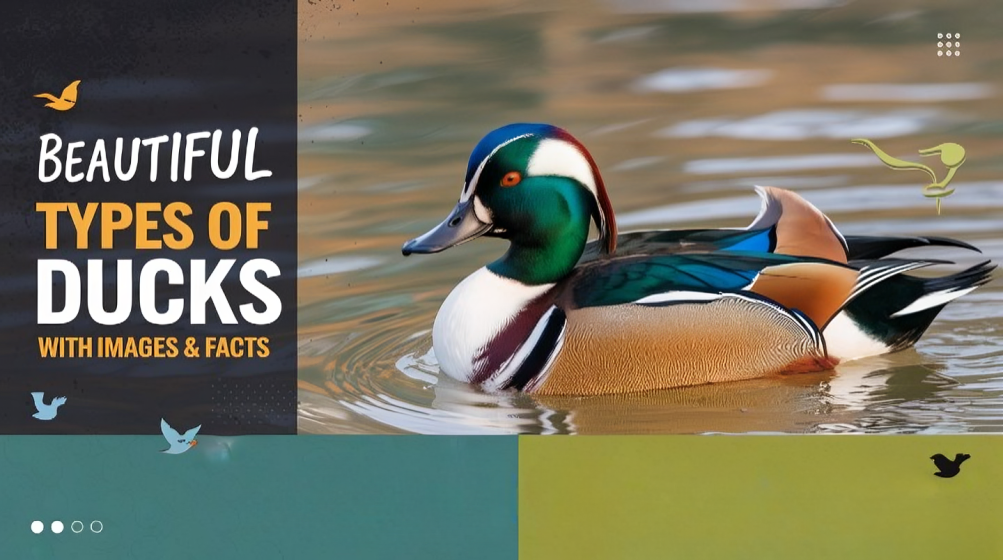There are many species of ducks found in India, each with its own unique colouration, pattern, and behaviour. From the majestic Indian Spot-billed Duck to the graceful Northern Pintail, witness the beauty of these remarkable birds. This article shares information about more than Beautiful Types of Ducks in India.
Types of Ducks in India
This is a list of domestic duck breeds. Beautiful types of ducks in India with pictures.
- Lesser Whistling Duck
- Ruddy Shelduck
- Northern Shoveler
- Indian Spot Billed Duck
- Northern Pintail
- Eurasian Teal Duck
- Common Pochard
- Garganey Duck
- Tufted Duck
- Knob Billed Duck
- Falcated Duck
- Mallard Duck
| Monk Parakeet Lifespan, Facts, History & More | 10 Ugly Dog Breeds You Need to See to Believe |
Lesser Whistling Duck
The Lesser Whistling Duck is a small, slender waterbird found in South and Southeast Asia. Known for its distinctive whistling call, the duck has a reddish-brown body and dark plumage. It prefers freshwater wetlands, marshes and lakes, often seen in large flocks. They are nocturnal feeders, eating mainly aquatic plants.
| Category | Details |
|---|---|
| Common Name | Lesser Whistling Duck |
| Scientific Name | Dendrocygna javanica |
| Habitat | Freshwater wetlands, lakes, ponds, and marshes across Southeast Asia and India |
| Physical Appearance | Medium-sized, brownish in color with a pale face and a white rump. Long legs and a straight posture |
| Call | Soft, high-pitched whistling sound |
| Behavior | Social, often found in large flocks. Active during dawn and dusk |
| Diet | Feeds on grains, seeds, aquatic plants, and small invertebrates |
| Breeding Season | Typically during the monsoon season, nesting near water sources |
| Conservation Status | Least Concern (IUCN), with stable populations across its range |
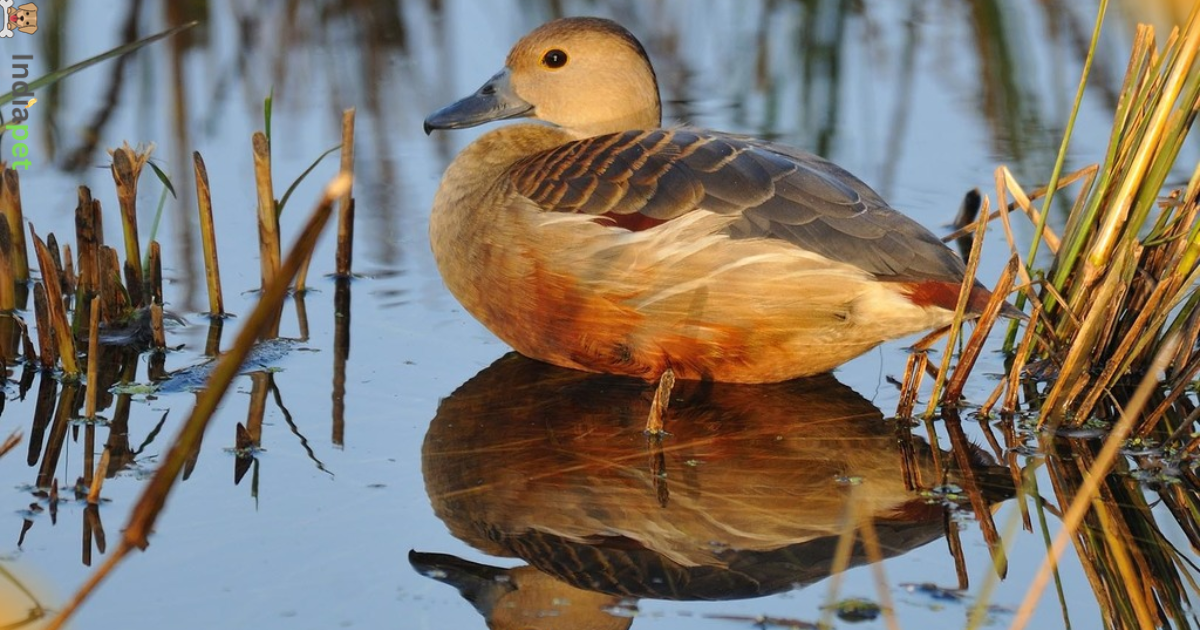
Ruddy Shelduck
The ruddy shelduck (Tadorna ferruginea), known as the brahminy duck in India, is a distinctive water bird, measuring 58 to 70 cm (23 to 28 in) in length and having a wingspan of 110 to 135 cm (43 to 53 in). There are very small populations of this species in northwestern Africa and Ethiopia.
It is omnivorous and feeds on grasses, young shoots, grains and aquatic plants. The Ruddy Shelduck is usually found in pairs or small groups and rarely in large flocks. The babies are cared for by both parents and begin to fly approximately eight weeks after hatching.
| Category | Details |
|---|---|
| Common Name | Ruddy Shelduck |
| Scientific Name | Tadorna ferruginea |
| Habitat | Lakes, rivers, wetlands, and marshes in Central and South Asia |
| Physical Appearance | Bright orange-brown body with a white head and black wingtips. The males have a black neck ring. |
| Diet | Feeds on grasses, aquatic plants, seeds, and small fish |
| Behavior | Migratory, usually seen in pairs. Known for loud honking calls and territorial behavior. |
| Conservation Status | Least Concern (IUCN), with stable populations across its range |
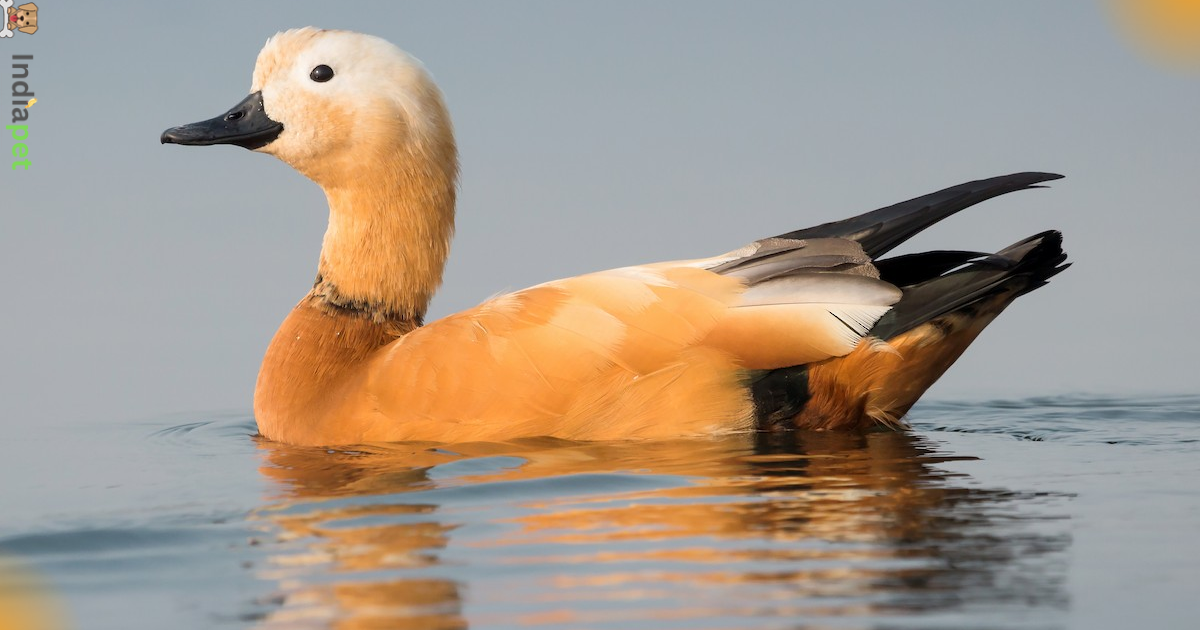
Northern Shoveler
Known in Britain as the Shoveler, they are 48 cm (19 in) long with a wingspan of 76 cm (30 in) and weigh 600 g (1.3 lb). The female has a brown forewing. The population has been healthy since the 1960s and in recent years numbers have risen to over 5 million (2015).
| Category | Details |
|---|---|
| Common Name | Northern Shoveler |
| Scientific Name | Spatula clypeata |
| Habitat | Freshwater marshes, lakes, and wetlands across North America, Europe, and Asia |
| Physical Appearance | Males have an iridescent green head, white chest, and rusty sides. Notable for their large, spatula-shaped bill. |
| Diet | Feeds on aquatic plants, seeds, and small invertebrates, filtering food through its large bill |
| Behavior | Migratory and social, often seen in mixed flocks. They swim in circles to stir up food. |
| Conservation Status | Least Concern (IUCN), with widespread and stable populations |

Indian Spot Billed Duck
The Indian Spot-billed Duck is a medium-sized dabbling duck commonly found in South Asia. Males are identified by their attractive greenish-black head, white neck and distinctive orange spot on the bill. Females are mottled brown with lighter faces.
The Indian Spot-billed Duck is a valuable part of its ecosystem, contributing to the health of wetland habitats. It measures 55–63 cm (22–25 in) in length and 83–95 cm (33–37 in) across the wings, and has a body mass of 790–1,500 g (1.74–3.31 lb).
| Category | Details |
|---|---|
| Common Name | Indian Spot-Billed Duck |
| Scientific Name | Anas poecilorhyncha |
| Habitat | Freshwater lakes, rivers, and wetlands in India and Southeast Asia |
| Physical Appearance | Grey-brown body with a distinctive yellow-tipped bill and red spots on the base of the bill. |
| Diet | Feeds on aquatic plants, small fish, and insects |
| Behavior | Often seen in pairs or small flocks. Known for their calm and shy demeanor. |
| Conservation Status | Least Concern (IUCN), with a stable population |

Northern Pintail
Northern Pintail females are mottled brown and have a lighter color. It is a beautiful and slender dabbling duck found in North America, Europe, and Asia. Males can be easily identified by their long necks, pointed tails, and attractive chocolate-brown heads with a white stripe down the neck.
| Category | Details |
|---|---|
| Common Name | Northern Pintail |
| Scientific Name | Anas acuta |
| Habitat | Wetlands, shallow lakes, and marshes in North America, Europe, and Asia |
| Physical Appearance | Males have a long neck with a slender body, brown head, and white stripe down the neck. Long tail feathers are distinctive. |
| Diet | Feeds on seeds, aquatic plants, and small invertebrates |
| Behavior | Migratory, usually seen in flocks. Fast, agile fliers known for their graceful flight. |
| Conservation Status | Least Concern (IUCN), though populations are subject to fluctuations |

Eurasian Teal Duck
The Eurasian Teal is the smallest of the British waterbirds. Outside the breeding season it is a very sociable duck and can form large flocks, with a body length of about 12 to 15 inches (30 to 38 cm).
| Category | Details |
|---|---|
| Common Name | Eurasian Teal |
| Scientific Name | Anas crecca |
| Habitat | Freshwater lakes, marshes, and rivers across Europe and Asia |
| Physical Appearance | Males have a chestnut head with a green eye patch and a grey body. Females are mottled brown. |
| Diet | Feeds on aquatic plants, seeds, and small invertebrates |
| Behavior | Highly migratory, often seen in flocks. Agile fliers and active during dawn and dusk. |
| Conservation Status | Least Concern (IUCN), with |
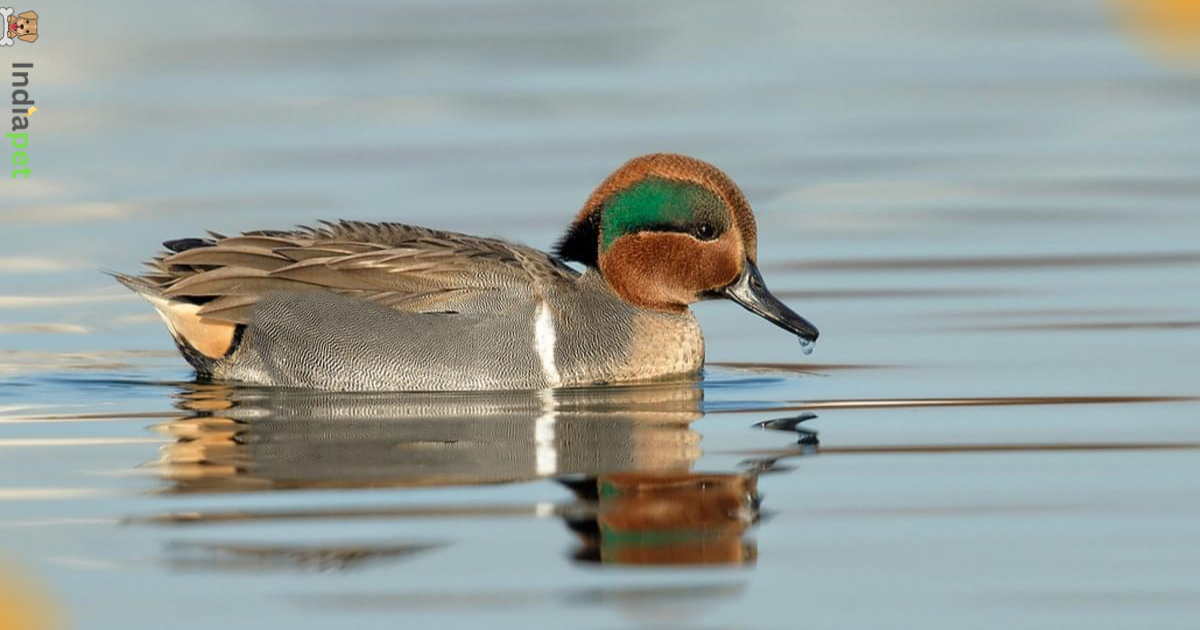
Common Pochard
A medium-sized diving duck in the family Anatidae. The Common Pochard, known as the Pochard in the United Kingdom, breeds mainly in the steppe regions of Scandinavia and Siberia, and spends the winters farther south and west, since it was first domesticated in China some 2,000 to 3,000 years ago.
| Category | Details |
|---|---|
| Common Name | Common Pochard |
| Scientific Name | Aythya ferina |
| Habitat | Freshwater lakes, ponds, and wetlands across Europe and Asia |
| Physical Appearance | Males have a chestnut-red head, black breast, and grey body. Females are brown with paler flanks. |
| Diet | Feeds on aquatic plants, seeds, and small invertebrates |
| Behavior | Migratory, forms large flocks in winter. Often dives for food. |
| Conservation Status | Vulnerable (IUCN), with declining populations due to habitat loss |

Garganey Duck
The garganey is a small dabbling duck. It breeds in much of Europe and the Paleoarctic, but is fully migratory, with its entire population migrating to Bangladesh, Africa, India, and Australia during the Northern Hemisphere winter.
They are 48 cm (19 in) long and have a wingspan of 76 cm (30 in) and weigh 600 g (1.3 lb). Garganey ducks use their highly specialized beaks to eat aquatic invertebrates as well as folding basal shovelers prefer to nest in grassy areas away from open water.
| Category | Details |
|---|---|
| Common Name | Garganey Duck |
| Scientific Name | Spatula querquedula |
| Habitat | Freshwater wetlands, lakes, and marshes in Europe, Africa, and Asia |
| Physical Appearance | Males have a distinctive white stripe over the eye with grey and brown body. Females are mottled brown. |
| Diet | Feeds on seeds, aquatic plants, and insects |
| Behavior | Migratory, traveling long distances. Often seen in mixed flocks during migration. |
| Conservation Status | Least Concern (IUCN), though populations fluctuate regionally |
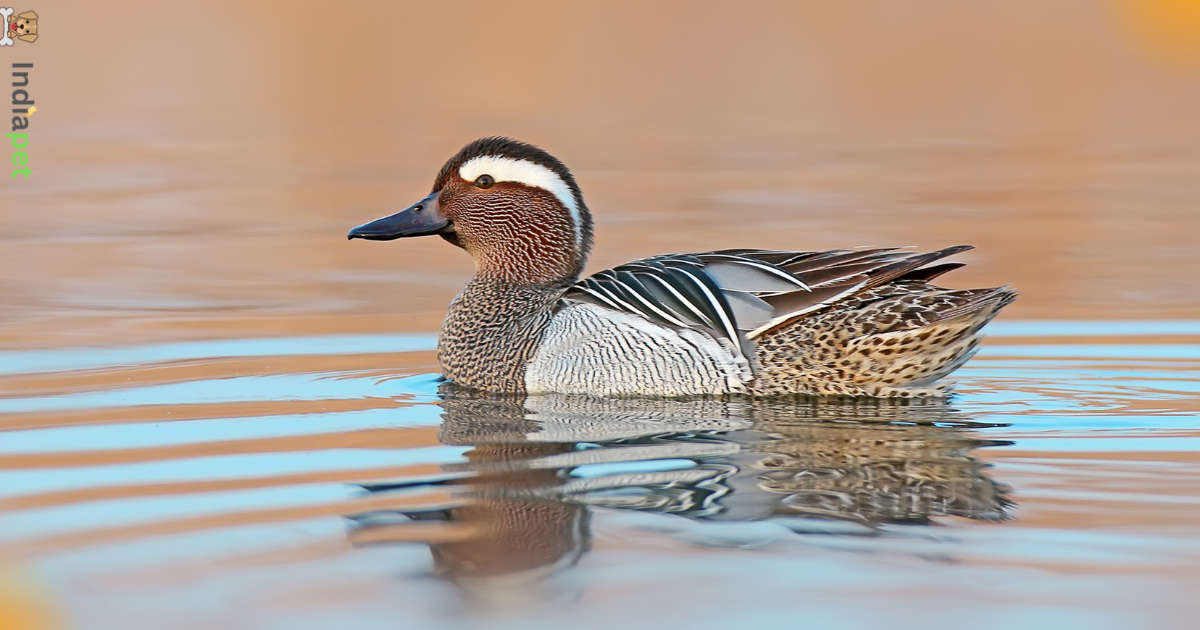
Tufted Duck
The Tufted Duck is a distinctive diving duck found throughout Europe and parts of Asia. Males are easily recognizable by their glossy black head, attractive tuft on the back, and white feathers.
Females are brownish in color, with a lighter tuft and a yellow face. These ducks prefer freshwater lakes and ponds and feed on aquatic plants, insects, and small fish. Average length 43.2 cm 43.2 cm.
| Category | Details |
|---|---|
| Common Name | Tufted Duck |
| Scientific Name | Aythya fuligula |
| Habitat | Freshwater lakes and ponds across Europe and Asia |
| Physical Appearance | Males are black with a white belly and have a distinctive tuft of feathers on their heads. Females are brown. |
| Diet | Feeds on aquatic plants, mollusks, and insects |
| Behavior | Migratory, often diving for food. Forms large flocks in winter. |
| Conservation Status | Least Concern (IUCN) |

Knob Billed Duck
Widely known as the comb duck or Necta knob-billed duck, it is found in freshwater rivers, lakes and swamps where it is usually rare. Generally silent. The length can range from 56 to 76 cm (22 to 30 in), the wingspan ranges from 116 to 145 cm (46 to 57 in) and the weight ranges from 1.03 to 2.9 kg (2.3 to 6.4 lb).
| Category | Details |
|---|---|
| Common Name | Knob-Billed Duck |
| Scientific Name | Sarkidiornis melanotos |
| Habitat | Freshwater lakes, rivers, and wetlands in Africa and South Asia |
| Physical Appearance | Males have a distinctive black knob on the bill. Both sexes have glossy green and black plumage with white underparts. |
| Diet | Feeds on aquatic plants, seeds, and small fish |
| Behavior | Non-migratory, often seen in small flocks. Known for their strong, heavy flight. |
| Conservation Status | Least Concern (IUCN), though habitat loss is a growing concern |
Falcated Duck
The falcated duck is a medium-sized dabbling duck found in parts of East Asia and Europe. The males are attractive with their bright green heads, slender necks and distinctive falcate (sword-like) tails.
The females are mottled brown and almost resemble a female mallard. Falcated ducks prefer shallow wetlands and marshlands, feeding mainly on aquatic plants and seeds. They are migratory and are known for their graceful flight patterns.
| Category | Details |
|---|---|
| Common Name | Falcated Duck |
| Scientific Name | Mareca falcata |
| Habitat | Freshwater lakes, rivers, and marshes in East Asia |
| Physical Appearance | Males have long, curved, metallic green feathers on the head and neck, giving them a falcated appearance. |
| Diet | Feeds on aquatic plants, seeds, and small invertebrates |
| Behavior | Migratory, often seen in mixed flocks during migration. |
| Conservation Status | Near Threatened (IUCN), with declining populations due to habitat destruction |
Mallard Duck
The mallard duck is a widely recognized waterfowl species found in North America, Europe, and Asia. The male has a vibrant green head, white neck ring, and chestnut-brown chest, while females are brown for camouflage.
Mallards live in a variety of freshwater environments and are known for their adaptability, varied diet, and distinctive screeching call.
| Category | Details |
|---|---|
| Common Name | Mallard Duck |
| Scientific Name | Anas platyrhynchos |
| Habitat | Lakes, ponds, rivers, and wetlands across North America, Europe, and Asia |
| Physical Appearance | Males have a glossy green head, white neck ring, and brown chest. Females are mottled brown. |
| Diet | Feeds on aquatic plants, insects, and small fish |
| Behavior | Migratory in some regions, highly social. Often forms large flocks, especially in winter. |
| Conservation Status | Least Concern (IUCN), with stable populations worldwide |

| Category | Details |
|---|---|
| Common Name | Common Pochard |
| Scientific Name | Aythya ferina |
| Habitat | Freshwater lakes, ponds, and wetlands across Europe and Asia |
| Physical Appearance | Males have a chestnut-red head, black breast, and grey body. Females are brown with paler flanks. |
| Diet | Feeds on aquatic plants, seeds, and small invertebrates |
| Behavior | Migratory, forms large flocks in winter. Often dives for food. |
| Conservation Status | Vulnerable (IUCN), with declining populations due to habitat loss |

Garganey Duck
The garganey is a small dabbling duck. It breeds in much of Europe and the Paleoarctic, but is fully migratory, with its entire population migrating to Bangladesh, Africa, India, and Australia during the Northern Hemisphere winter.
They are 48 cm (19 in) long and have a wingspan of 76 cm (30 in) and weigh 600 g (1.3 lb). Garganey ducks use their highly specialized beaks to eat aquatic invertebrates as well as folding basal shovelers prefer to nest in grassy areas away from open water.
| Category | Details |
|---|---|
| Common Name | Garganey Duck |
| Scientific Name | Spatula querquedula |
| Habitat | Freshwater wetlands, lakes, and marshes in Europe, Africa, and Asia |
| Physical Appearance | Males have a distinctive white stripe over the eye with grey and brown body. Females are mottled brown. |
| Diet | Feeds on seeds, aquatic plants, and insects |
| Behavior | Migratory, traveling long distances. Often seen in mixed flocks during migration. |
| Conservation Status | Least Concern (IUCN), though populations fluctuate regionally |

Tufted Duck
The Tufted Duck is a distinctive diving duck found throughout Europe and parts of Asia. Males are easily recognizable by their glossy black head, attractive tuft on the back, and white feathers.
Females are brownish in color, with a lighter tuft and a yellow face. These ducks prefer freshwater lakes and ponds and feed on aquatic plants, insects, and small fish. Average length 43.2 cm 43.2 cm.
| Category | Details |
|---|---|
| Common Name | Tufted Duck |
| Scientific Name | Aythya fuligula |
| Habitat | Freshwater lakes and ponds across Europe and Asia |
| Physical Appearance | Males are black with a white belly and have a distinctive tuft of feathers on their heads. Females are brown. |
| Diet | Feeds on aquatic plants, mollusks, and insects |
| Behavior | Migratory, often diving for food. Forms large flocks in winter. |
| Conservation Status | Least Concern (IUCN) |

Knob Billed Duck
Widely known as the comb duck or Necta knob-billed duck, it is found in freshwater rivers, lakes and swamps where it is usually rare. Generally silent. The length can range from 56 to 76 cm (22 to 30 in), the wingspan ranges from 116 to 145 cm (46 to 57 in) and the weight ranges from 1.03 to 2.9 kg (2.3 to 6.4 lb).
| Category | Details |
|---|---|
| Common Name | Knob-Billed Duck |
| Scientific Name | Sarkidiornis melanotos |
| Habitat | Freshwater lakes, rivers, and wetlands in Africa and South Asia |
| Physical Appearance | Males have a distinctive black knob on the bill. Both sexes have glossy green and black plumage with white underparts. |
| Diet | Feeds on aquatic plants, seeds, and small fish |
| Behavior | Non-migratory, often seen in small flocks. Known for their strong, heavy flight. |
| Conservation Status | Least Concern (IUCN), though habitat loss is a growing concern |
Falcated Duck
The falcated duck is a medium-sized dabbling duck found in parts of East Asia and Europe. The males are attractive with their bright green heads, slender necks and distinctive falcate (sword-like) tails.
The females are mottled brown and almost resemble a female mallard. Falcated ducks prefer shallow wetlands and marshlands, feeding mainly on aquatic plants and seeds. They are migratory and are known for their graceful flight patterns.
| Category | Details |
|---|---|
| Common Name | Falcated Duck |
| Scientific Name | Mareca falcata |
| Habitat | Freshwater lakes, rivers, and marshes in East Asia |
| Physical Appearance | Males have long, curved, metallic green feathers on the head and neck, giving them a falcated appearance. |
| Diet | Feeds on aquatic plants, seeds, and small invertebrates |
| Behavior | Migratory, often seen in mixed flocks during migration. |
| Conservation Status | Near Threatened (IUCN), with declining populations due to habitat destruction |
Mallard Duck
The mallard duck is a widely recognized waterfowl species found in North America, Europe, and Asia. The male has a vibrant green head, white neck ring, and chestnut-brown chest, while females are brown for camouflage.
Mallards live in a variety of freshwater environments and are known for their adaptability, varied diet, and distinctive screeching call.
| Category | Details |
|---|---|
| Common Name | Mallard Duck |
| Scientific Name | Anas platyrhynchos |
| Habitat | Lakes, ponds, rivers, and wetlands across North America, Europe, and Asia |
| Physical Appearance | Males have a glossy green head, white neck ring, and brown chest. Females are mottled brown. |
| Diet | Feeds on aquatic plants, insects, and small fish |
| Behavior | Migratory in some regions, highly social. Often forms large flocks, especially in winter. |
| Conservation Status | Least Concern (IUCN), with stable populations worldwide |

